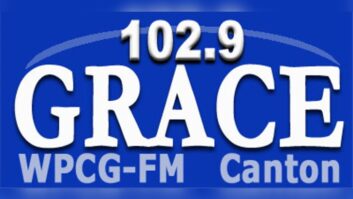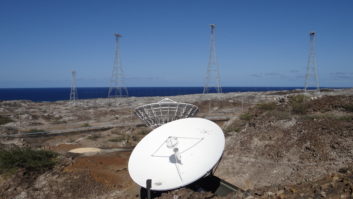Thoughts on FM
Aug 1, 2001 12:00 PM, By John Battison, P.E., technical editor, RF
I often wonder if Major Armstrong knew what he was giving to the world when he began developing frequency modulation as a public service. Before World War Two, when the low-band FM service was a comparatively high frequency, it seems that not much attention had been paid to possible long distance interference produced by local VHF broadcasts. Not long after WW2, it was discovered that the BBC TV broadcasts were receiving interference from the Chicago Police transmissions. This led to a reevaluation of the frequency allocations, and our TV channel 1, which was in the top end of the 40MHz band, was deleted. Fortunately, no channel 1 stations had been built, although one channel 1 CP had been issued. This was quickly changed to another usable channel.
Armstrong’s tower in Alpine, NJ, is still being used today, but houses only one FM broadcast signal.

By the time that the TV problems had arisen, our FM service had long since been changed to the high band at twice the original allocation frequency. This was particularly important to me because my first job at KMBC in November 1945 was to convert its low-band FM transmitter to 99.7MHz. Happily, the new frequency was exactly twice the old one. It was only necessary to build a doubler stage and a new PA, and then find a new antenna. The latter was the hardest part.
The station also had an experimental television license and a fine laboratory on the top floor of the Kansas City Power and Light Building. This was where I did my development work on the new transmitter. The station would have preferred to buy a new transmitter, but none were available at that time (the �don’t you know there’s a war on?� attitude still prevailed).
I had the idea that it might be possible to obtain a circular pattern by means of some kind of long radiator around the top of the tower because it was not easy to buy FM antennas in those days.
Unfortunately, all the details of my idea have been lost and forgotten. I do recall, however, that the pattern seemed quite circular, but in the absence of any measuring equipment, all I could do was to compare reception at different points on a receiver and a whip antenna.
Fortunately, a Federal triangular FM antenna became available suddenly, and the problem was solved before the FCC looked into my experiments.
A simple start
When Major Armstrong was developing FM, he probably used simple dipole antennas at first. Then, as the commercial application of the new medium began to appear, he no doubt gave attention to the method of radiating the new signal.
It must have been obvious as Major Armstrong progressed with the development of FM that the narrow bandwidth and highly directional properties of dipoles would hinder FM’s growth unless patterns and characteristics were modified. It was necessary to develop antennas with broad bandwidths, lower Q and more or less circular patterns. It’s interesting to reflect on the fact that the original humble, simple, single-dipole radiator has become important today as a major part of the popular panel antenna. Although the windloading tends to be a little high, the panel-dipole antenna produces one of the most circular patterns available in FM.
A circularly polarized antenna, such as this FMA-727 from Armstrong Transmitters, provides a signal in both the horizontal and vertical planes.

Fifty years ago we didn’t have an EPA, and no one worried about the effects of RF non-ionizing radiation (and no one yet has proved that it hurts us). However, the FM antenna manufacturer still has to contend with downward radiation and consider antenna bay spacing in his design.
Antenna-bay spacing and number of bays still seem to control the level of downward radiation as modified by various antenna engineers. Over the years, simple FM broadcasting has matured into a highly technical operation, in many ways, perhaps, more complicated than the directional AM antenna field. As FM ERP has increased and stabilized, matters that probably were not even considered have now become essential.
Some time around 1960, in an effort to improve stability of reception, a number of FM antenna manufacturers developed circular polarization (CPOL). The FCC permitted equal power in both horizontal and vertical polarizations, but vertical power may never exceed horizontal. Coverage is based on the horizontal signal, and vertical power is not considered when calculating contours.
It was anticipated that CPOL would improve reception for receivers using line cords as antennas (with various polarizations), as well as auto radios and in areas of tall buildings and mountainous terrain. In many cases, reception did improve; however, it was found that maximum improvement could only be obtained by using CPOL receiving antennas as well. Unfortunately, few people can find CPOL receiving antennas. Nevertheless, there is a definite benefit in most cases because the average listening location will likely have a wider choice of signal polarizations, with a better chance of capturing a clean signal.
As CPOL antenna development continued and directional antenna usage increased, HPOL and VPOL patterns frequently showed large differences in polarization coverage. An HPOL plot might show excellent coverage of the city of license, while VPOL coverage is poor and vice versa. This has led to the introduction of short vertical parasitic correction rods located near the antenna in an attempt to make the two polarizations provide overlapping coverage by modifying the vertical signal.
The use of CP requires twice the transmitter power, or twice the antenna gain, needed for HPOL to provide equivalent vertical and horizontal coverage. This often poses financial questions of transmitter operating costs versus antenna support costs.
As the number of bays increases, other problems arise. Neglecting tower windloading, the greater the antenna gain, the narrower the vertical beamwidth. Wide bay spacing of up to one wavelength tends to increase the radiation at extreme angles of elevation. This means that more power is directed downward (frowned upon by the EPA) and into the air, where there are no listeners. High elevation radiation can be reduced by using half-wave spacing, which also reduces the tower space required, and multiple sidelobes can be reduced by careful bay spacing and feeder design.
About 50 years ago not much attention was paid to the vertical patterns of the relatively simple HPOL antennas, unless the antenna was on a very tall tower or a high mountaintop, possibly resulting in signals passing over the city of license. Thus, electrical beam tilt found its way into our engineering vocabulary, together with new interest in the vertical radiation pattern.
E-mail John at[email protected].












